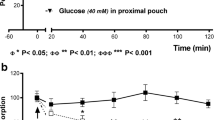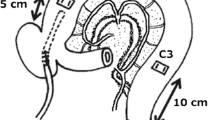Abstract
The effects of the close intraarterial administration of motilin on intestinal myoelectric and contractile activities were examined in 37 dogs. After anesthetization or decerebration, a segment of proximal jejunum was instrumented serosally with electrodes and stain gauges. A mesenteric artery supplying a short length of this segment was cannulated for the injection of motilin and other agents. Motilin (0.03–0.3 μg) caused: (1) a series (1–5 min) of phasic contractions and electrical response activity (ERA) bursts locally; (2) a short (15–60 sec) series of phasic contractions and ERA bursts aborally followed by relaxation; and (3) a series of phasic contractions and ERA bursts whose onset migrated 3.7±1.0 cm orally. The length of orad response increased to 6.6±1.9 cm in the decerebrate dogs (P<0.01). No other tested agent, including serotonin, bethanechol, morphine, dopamine, substance P, neurotensin, somatostatin, vasoactive intestinal peptide, bombesin, pentagastrin, cholecystokinin octapeptide, prostaglandin F2α or leucine-enkephalin, cuased similar responses. All motilin responses were mediated by neural pathways consisting of both nicotinic and muscarinic receptors. The similarity of responses and mechanisms of action of the motilin-activated contractile response with the intrinsic mucosal reflex suggested that motilin may mediate this reflex.
Similar content being viewed by others

References
Polak JM, Heitz P, Pearse AGE: Differential localization of substance P and motilin. Scand J Gastroenterol 11(Suppl 39):39–42, 1976
Pearse AGE: The cellular origin of motilin in the gastrointestinal tract. Scand J Gastroenterol 11(Suppl 39):35–38, 1976
Smith PH, Davis BJ, Seino Y, Yanaihara N: Localization of motilin-containing cells in the intestinal tract of mammals: A further comparison using region-specific motilin antisera. Gen Comp Endocrinol 44:288–291, 1981
Forssmann WG, Yanaihara N, Helmstaedter V, Grube D: Differential demonstration of the motilin cell and the enterochromaffin cell. Scand J Gastroenterol 11(Suppl 39):43–45, 1976
Kishimoto S, Polak JM, Buchan AMJ, Verhofstad AAJ, Steinbusch HWM, Yanaihara N, Bloom SR, Pearse AGE: Motilin cells investigated by the use of region-specific antisera. Virchows Arch Cell Pathol 36:207–218, 1981
Itoh Z, Honda R, Hiwatashi K, Takeuchi S, Aizawa I, Takayanagi R, Couch EF: Motilin-induced mechanical activity in the canine alimentary tract. Scand J Gastroenterol 11(Suppl 39):93–110, 1976
Wingate DL, Ruppin H, Green WER, Thompson HH, Domschke W, Wünsch E, Demling L, Ritchie HD: Motilin-induced electrical activity in the canine gastrointestinal tract. Scand J Gastroenterol 11(Suppl 39):111–118, 1976
Itoh Z, Takeuchi S, Aizawa I, Mori K, Taminato T, Seino S, Imura H, Yanaihara N: Changes in plasma motilin concentration and gastrointestinal contractile activity in conscious dogs. Am J Dig Dis 23:929–935, 1978
Chey WY, Lee KY, Tai H-H: Endogenous plasma motilin concentration and interdigestive myoelectric activity of the canine duodenum.In Gut Hormones. SR Bloom (ed). Edinburgh, Churchill Livingston, 1978, pp 355–358
Poitras P: Motilin is a digestive hormone in the dog. Gastroenterology 87:909–913, 1984
Sarna S, Chey WY, Condon RE, Dodds WJ, Myers T, Chang T: The cause-and-effect relationship between motilin and migrating myoelectric complexes (MMCs). Am J Physiol 245:G277-G284, 1983
Hall KE, Greenberg GR, El-Sharkawy TY, Diamant N: Relationship between procine motilin-induced migrating motor complex-like activity, vagal integrity, and endogenous motilin release in dogs. Gastroenterology 87:76–85, 1984
Poitras P, Steinbeck JH, Van Deventer G, Code CF, Walsh JH: Motilin-independent ectopic fronts of the interdigestive myoelectric complex in dogs. Am J Physiol 239(3):214–220, 1980
Sarna S, Condon RE, Cowles V: The enteric mechanism of initiation of migrating myoelectric complexes (MMCs) in dogs. Gastroenterology 84:814–822, 1983
Hukuhara T, Sumi T, Kotani S: Comparative studies on the intestinal intrinsic reflexes in rabbits, guinea pigs and dogs. Jpn J Physiol 11:205–211, 1961
Cook MA, Kowalewski K, Daniel EE: Electrical and mechanical activity recorded from the isolated, perfused canine stomach: The effect of some GI polypeptides.In Proceedings of the 4th International Symposium on GI Motility. EE Daniel (ed). Vancouver, Canada, Michell Press, 1974, pp 233–242
You CH, Lee KY, Chey WY: Plasma motilin level and interdigestive motor complex in normal and abnormal states in man.In Functional Disorders of the Digestive Tract. WY Chey (ed). New York, Raven Press, 1983, pp 213–217
Green WER, Ruppin H, Wingate DL, Domschke W, Wünsch E, Demling L, Ritchie HD: Effecss of 13-n13-motilin on the electrical and mechanical activity of the isolated perfused canine stomach and duodenum. Gut 17:362–370, 1976
Hirning J, Burks T: Characterization of motilin induced contractions of the isolated canine intestine. Proc West Pharmacol Soc 26:57–59, 1983
Strunz V, Domschke W, Mitznegg P, Domschke S, Schubert E, Wünsch E, Jaeger E, Demling L: Analysis of the motor effect of 13-norleucine motilin on the rabbit, guinea pig, rat, and human alimentary tractin vitro. Gastroenterology 68:1485–1491, 1975
Domschke W, Strunz V, Mitznegg P, Domschke S, Wunsch E, Demling L: Motilin and motilin analogues: Mode of action. Scand J Gastroenterol 11(Suppl 39):25–28, 1976
Adachi H, Toda N, Hayoshi S, Noguchi M, Suzuki T, Torizuko K, Yajima H, Koyama K: Mechanism of the excitatory action of motilin on isolated rabbit intestine. Gastroenterology 80:783–788, 1981
Strunz V, Domschke W, Domschke S, Mitznegg P, Wünsch E, Jaeger E, Demling L: Gastroduodenal motor response to natural motilin and synthetic position 13-substituted motilin analogues: A comparativein vitro study. Scand J Gastroenterol 11:199–203, 1976
Solcia E, Capella C, Buffa R, Usellini L, Fiocca R, Frigerio B, Tenti P, Sessa F: The diffuse endocrine-paracrine system of the gut in health and disease: Ultrastructural features. Scand J Gastroenterol 16(Suppl 70)25–36, 1981
Matsuo Y, Seki A: The coordination of gastrointestinal hormones ad the autonomic nerves. Am J Gastroenterol 69:21–50, 1978
Wise L, Burkholder J, Zagoloff A, Schuck M, Ballinger WF II: Studies on the role of serotonin in the inhibition of gastric acid secretion by the duodenum. Ann Surg 168:824–830, 1968
Shapiro H, Woodward ER: Inhibition of the secretin mechanism by local anesthetics. Ann Surg 31:139–141, 1968
Lang IM, Tansy MF: Mechanism of the secretory and motor responses of the Brunner's gland region of the intestines to duodenal acidification. Pfluegers Arch 396:115–120, 1983
Wood JD: Excitation of intestinal muscle by atropine, tetrodotoxin and xylocaine. Am J Physiol 222:118–125, 1972
Biber B, Fara J: Intestinal motility increased by tetrodotoxin, lidocaine, and procaine. Experientia 29:551–552, 1973
Bortoff A, Muller R: Stimulation of intestinal smooth muscle by atropine, procaine, and tetrodotoxin. Am J Physiol 229:1609–1613, 1975
Yokoyama S, Ozaki T: Polarity of effects of stimulation of Auerbach's plexus on longitudinal muscle. Am J Physiol 235(4):E345-E353, 1978
Franz DN: Drugs acting on the central nervous system.In The Pharmacological Basis of Therapeutics. LS Goodman, A Gilman (eds). New York, Macmillan, 1975, pp 47–53
Hukuhara T, Yamagani M, Nakayama S: On the intestinal intrinsic reflexes. Jpn J Physiol 8:9–20, 1958
Hukuhara T, Nakayama S, Sumi T: The role of the intrinsic mucosal reflex in the fluid transport through the denervated intestinal loop. Jpn J Physiol 9:406–418, 1959
Thomas JE, Baldwin MV: The intestinal mucosal reflex in the unanesthetized dog. Am J Dig Dis 16:642–647, 1971
Gershon MD, Bursztajn S: Properties of the enteric nervous system: Limitation of access of intravascular macromolecules to the myenteric plexus and muscularis externa. J Comp Neurol 180:467–488, 1978
Lundberg JM, Dallstrom A, Bylock A, Ahlman H, Pettersson G, Larsson I, Hansson HA, Kerventer J: Ultrastructural evidence for an innervation of epithelial enterochromaffin cells in guinea pig duodenum. Acta Physiol Scand 104:3–12, 1978
Author information
Authors and Affiliations
Additional information
This work was supported in part by VA grant 7722-01P.
Rights and permissions
About this article
Cite this article
Lang, I.M., Sarna, S.K. & Condon, R.E. Myoelectric and contractile effects of motilin on dog small intestinein vivo . Digest Dis Sci 31, 1062–1072 (1986). https://doi.org/10.1007/BF01300259
Received:
Revised:
Accepted:
Issue Date:
DOI: https://doi.org/10.1007/BF01300259



